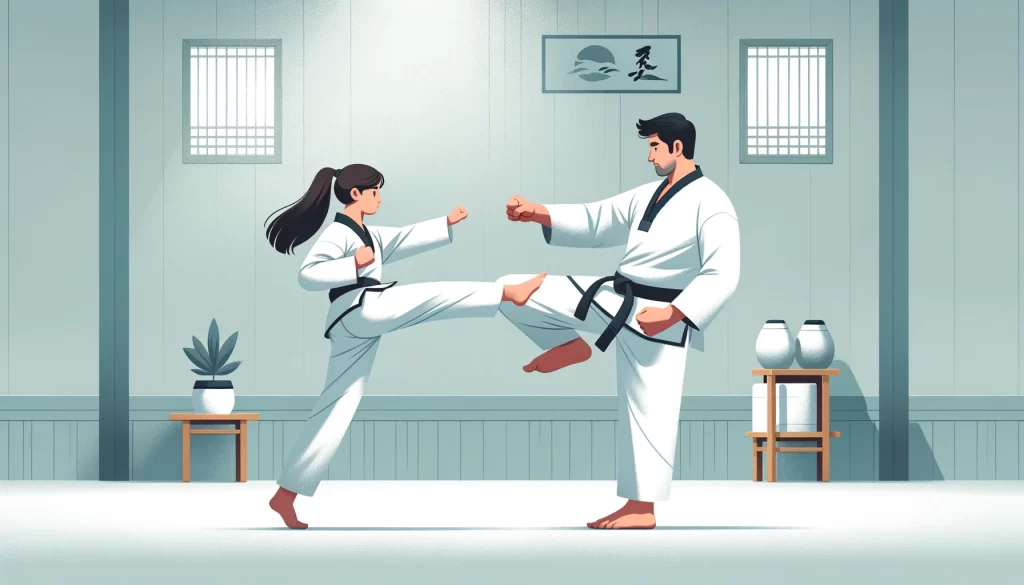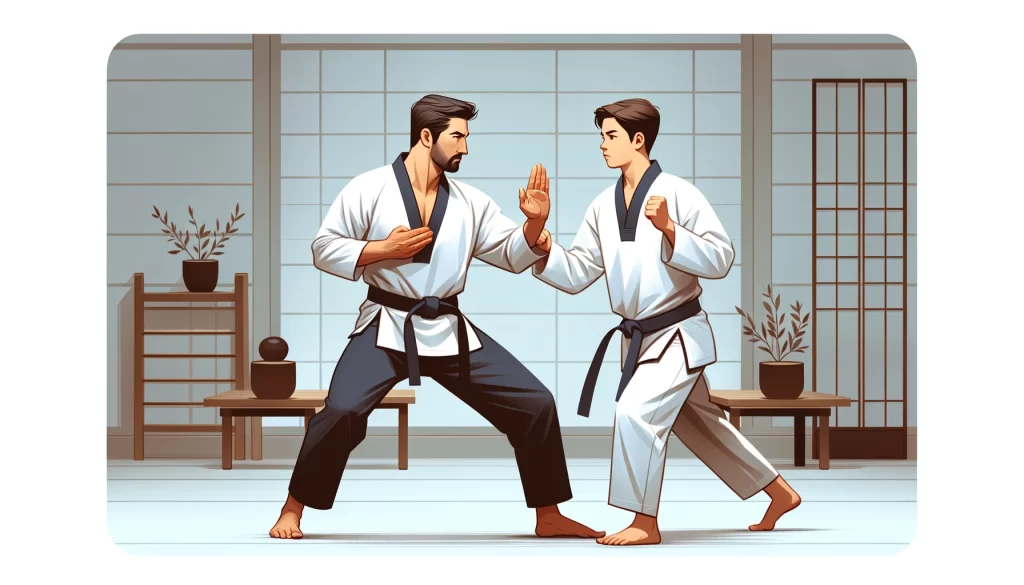Discover the Art of Taekwondo: From Self-Defense to Olympic Sport
Are you ready to delve into the fascinating world of Taekwondo? This Korean martial art, known for its dynamic kicks and sharp strikes, is not just a form of self-defense but also an Olympic sport. Let’s explore the essence of Taekwondo and unravel its rich history, philosophy, and benefits.
The Essence of Taekwondo

Taekwondo is a martial art that originated in Korea and has gained worldwide popularity for its emphasis on self-discipline, respect, and indomitable spirit. Practitioners of Taekwondo undergo rigorous training to master various techniques such as kicks, punches, and sparring. Taekwondo enhances physical agility and fosters a sense of community and personal growth, making it a transformative experience for many who practice it.
History and Origins of Taekwondo
The history of Taekwondo can be traced back to ancient Korea, where it was practiced as a form of self-defense and combat training. Over the centuries, Taekwondo evolved into a distinct martial art with its own set of traditions and techniques. In the 20th century, Taekwondo was formally established and spread beyond Korea, thanks to efforts in America to promote this martial art.
Tenets and Philosophy of Taekwondo
Taekwondo emphasizes the five tenets of courtesy, integrity, perseverance, self-control, and indomitable spirit. These principles form the foundation of Taekwondo training, instilling values of respect, humility, and discipline in practitioners. The philosophy of Taekwondo goes beyond physical combat, promoting mental strength and character development.
Benefits of Practicing Taekwondo
Practicing Taekwondo offers a wide range of benefits, including improved physical fitness, mental focus, and self-confidence. As a full medal sport in the Olympics, Taekwondo provides opportunities for athletes to compete at a world-class level. Additionally, Taekwondo training enhances self-defense skills and promotes overall well-being through its emphasis on holistic development.
Understanding Taekwondo as a Martial Art

Taekwondo is known for its dynamic kicks, precise strikes, and strategic sparring techniques that not only make it an effective form of self-defense but also a highly respected Olympic sport. Taekwondo is much more than physical prowess; it offers a glimpse into a way of life that values discipline, respect, and a continuous pursuit of excellence.
Practitioners, from novices to seasoned black belts, learn to harness both mental and physical strength, fostering resilience and a deep-rooted sense of community. Engaging with Taekwondo provides a unique opportunity to challenge oneself and grow in ways that extend far beyond the training mat.
The Techniques and Forms of Taekwondo
Taekwondo encompasses a wide range of techniques, including powerful kicks, swift punches, and effective blocks, all of which are integrated into patterns known as poomsae. These forms emphasize fluid movements, balance, and precision, serving as a crucial component in mastering the art of Taekwondo and developing one’s physical and mental discipline.
The Role of Poomsae in Taekwondo
Poomsae, also referred to as forms or patterns, are choreographed sequences of movements that simulate combat scenarios. By practicing poomsae, Taekwondo practitioners refine their stances, transitions, and techniques, fostering muscle memory and enhancing their overall performance in sparring and self-defense situations.
Training and Discipline in Taekwondo
The essence of Taekwondo lies in its rigorous training regimen that instills discipline, focus, and perseverance in practitioners. Through structured practice sessions, students develop physical agility, mental fortitude, and respect for the art, embodying the core tenets of Taekwondo both in and out of the training environment.
Self-Defense in Taekwondo

Self-defense in Taekwondo involves the use of practical moves that are designed to empower individuals with the skills to protect themselves in various situations. These self-defense techniques are not only focused on physical strength but also on mental alertness and quick reflexes to overcome potential threats efficiently.
Practical Self-Defense Moves in Taekwondo
Taekwondo practitioners learn a range of self-defense moves, including blocks, strikes, and evasion techniques tailored to real-life scenarios. These moves emphasize speed, accuracy, and leveraging the opponent’s energy, enabling individuals to defend themselves effectively in confrontational situations.
Empowerment and Confidence Through Taekwondo
Participating in Taekwondo training fosters a sense of empowerment and confidence in individuals. As practitioners progress in their martial arts journey, they develop a strong mindset, self-assurance, and a belief in their abilities to overcome challenges both inside and outside the dojang walls.
Safeguarding Techniques Taught in Taekwondo
One of the core elements of Taekwondo training is learning safeguarding techniques that focus on protecting oneself and others from harm. These techniques involve understanding body mechanics, maintaining awareness of surroundings, and applying strategic moves to ensure personal safety in potentially dangerous situations.
Taekwondo as an Olympic Sport

The Evolution of Taekwondo in the Olympics
Since its inclusion as an official Olympic sport in 2000, Taekwondo has gained recognition on the global stage, captivating audiences with its blend of technique and strategy. The journey of Taekwondo in the Olympics showcases the skill and proficiency of athletes, highlighting the elegance and power of this Korean martial art. Over the years, Taekwondo has evolved to become a highly competitive sport that demands athleticism, precision, and mental fortitude from its practitioners.
Competitions and Rules of Taekwondo in the Olympics
In Olympic Taekwondo competitions, athletes engage in dynamic sparring matches where they score points by landing precise kicks and punches on their opponents. The rules of Olympic Taekwondo are governed by the World Taekwondo Federation (WTF), ensuring fair play, sportsmanship, and adherence to the principles of martial arts. Competitors must showcase not only their physical prowess but also their strategic prowess in navigating the fast-paced and tactical nature of Olympic Taekwondo bouts.
Achievements of Taekwondo Athletes in the Olympics
Throughout the history of Taekwondo in the Olympics, talented athletes have demonstrated exceptional skill and sportsmanship, earning medals and accolades for their dedication to the sport. From breathtaking kicks to strategic defense, Taekwondo athletes have showcased the diversity and beauty of this martial art on the Olympic stage. Their achievements not only inspire the next generation of practitioners but also solidify Taekwondo’s status as a prestigious and revered Olympic sport.
Frequently Asked Questions:
Q: What is Taekwondo and how does it differ from other martial arts forms like karate?
A: Taekwondo is a Korean martial arts form known for its emphasis on high kicks and fast hand techniques, which makes it distinct from other forms such as karate, which focuses more on hand strikes and is Japanese in origin. Taekwondo is not only a form of martial arts but also a sport and a way of life, emphasizing discipline, respect, and self-improvement.
Q: When and where did Taekwondo originate?
A: Taekwondo originated in Korea and is one of the oldest forms of martial arts in the world, with a history dating back over 2,000 years. The term “taekwondo” itself was officially adopted in the 1950s, but the art’s roots trace back to ancient Korean techniques known as “tae kyon.”
Q: Can you schedule a tour to learn more about Taekwondo?
A: Yes, many taekwondo schools and academies offer tours and introductory sessions for prospective students to learn more about the training experience and philosophy of taekwondo. Scheduling a tour is a great way to meet the master instructors, observe a class, and ask questions about how to start practicing this martial art.
Q: What are the tenets of Taekwondo?
A: The tenets of taekwondo emphasize the ethical and philosophical aspects of this martial art. They include courtesy, integrity, perseverance, self-control, and indomitable spirit. These principles guide the training and behavior of taekwondo practitioners both inside and outside the dojang (training hall).
Q: How has Taekwondo evolved into an Olympic sport?
A: Taekwondo became a full medal sport at the Sydney 2000 Olympic Games, after being a demonstration sport in previous Games. Its inclusion reflects the worldwide popularity and recognition of taekwondo as a competitive sport and a disciplined form of martial arts. The World Taekwondo Federation (WTF) is the governing body responsible for taekwondo in the Olympics.
Q: What are the different styles or organizations within Taekwondo?
A: There are several organizations within the world of taekwondo, notably the World Taekwondo Federation (WTF) and the International Taekwon-Do Federation (ITF). Each has its own rules, philosophies, and techniques. The WTF focuses on Olympic-style sparring, while ITF emphasizes traditional taekwondo patterns and self-defense techniques.
Q: How is Taekwondo used for self-defense?
A: Taekwondo is highly effective for self-defense, emphasizing speed, agility, and power. It teaches practitioners to use their legs for both attack and defense, utilizing a range of kicks, as well as the art of blocking and striking with the hands. The training also includes learning to anticipate and counter attacks from opponents.
Q: What makes Taekwondo unique compared to other martial arts?
A: What sets taekwondo apart is its focus on kicks and leg techniques, which is attributed to the theory that the leg is the longest and strongest tool a martial artist has at their disposal. Additionally, taekwondo incorporates a philosophical and cultural element that teaches respect, peace, and discipline, making it not just a martial art but a way of life.
Q: How can I start practicing Taekwondo?
A: Starting taekwondo involves finding a reputable dojang (taekwondo school) and a certified instructor. Most schools offer beginner classes and provide a structured program to progress through the ranks. It’s also beneficial to attend an introductory class or tour the facility to ensure it aligns with your interests and goals in practicing taekwondo.
